Find a Home, Building, Business or Structure
DO NOT DISTURB PROPERTY OWNER.
- Anders Hintze House
- David Brinton House
- Santa Anna Casto House
- George and Elizabeth Taylor Boyes House
- David McDonald House
- Morton A. Cheesman House
- Milo Andrus Jr. House
- William and Annie Livingston House
- Ross Hame
- Harold W. and Evelyn Burton House
- Drage House
- Fenno Casto House
- Holladay City Hall
- Health Industries Inc. Office Building
- Jane and Ralph Reynolds House
- Leona Gustavson House
- Gustavson House 2062
- Gustavson House 2044
- The Geraldine
- The Dude
- The Sunny Dale
- The Cosmopolitan
- The Red Robin
- The Connecticut Yankee
- Bel Vista
- Home #15
- The Dover
- The Virginian Jr.
- The Cotton Bottom Inn
- The Cottage at Knudsen’s Corner
- Meier’s
- Burton Lumber
- The Store
- Leslie’s French Pastries
- Ware & Treganza Bridge
CHECK OUT THE MAP OF HISTORIC HOLLADAY
1. Anders Hintze House (APPROX. 1860)

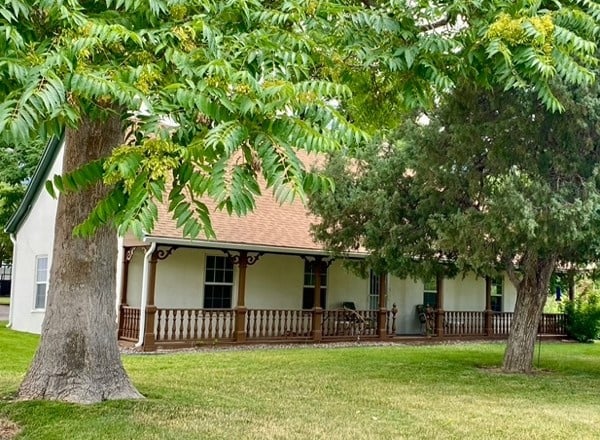
National Register of Historic Places
4249 S. 2300 E.
The Anders Hintze house in Holladay is significant as an example of "The Scandinavian-American Pair-house in Utah” and remains one of the few homes in the Salt Lake Valley dating to the 1860s. It is one story high and is built of locally-produced adobe which was plastered over at an early date. The present stucco exterior was applied in the 1940s and remains consistent with the house's historic appearance. A small adobe lean-to bedroom extension was appended to the original house at the southwest corner. A scroll-bracketed porch once ran the length of the historic house, was removed decades ago, then was replaced to match the original porch. The original stone root cellar, separate from the house, remains in good condition.
Anders Hintze was born in 1821 in Roskilde Parish, Denmark. He emigrated to Utah in the early 1860s. Arriving in Salt Lake City, he received a land grant which extended from 3900 South to 4500 South and from 2300 East to 2700 East. A farmer by trade, Hintze prospered and eventually married three wives. Despite the relatively large size of the home, only one wife, Karen Sophie Swenson, lived in the main house. The other wives occupied smaller houses located on the family property. After Anders Hintze's death in 1888, the house passed to his son, Ferdinand. The younger Hintze married four wives and held the dubious honor of being the first Mormon arrested under the provisions of the Edmunds Act (anti-polygamy) in 1882.
The house is still in the Hintze family and currently occupied by Anders Hintze’s great, great granddaughter.
Source: United States Department of the Interior National Park Service National Register of Historic Places, Anders Hintze House
2. David brinton house (Approx. 1860-1896)
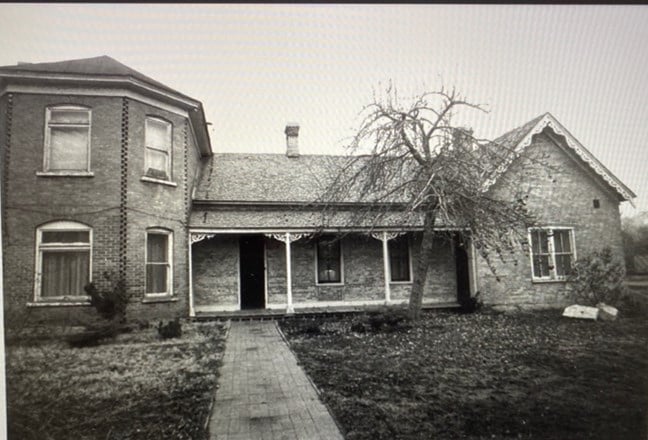
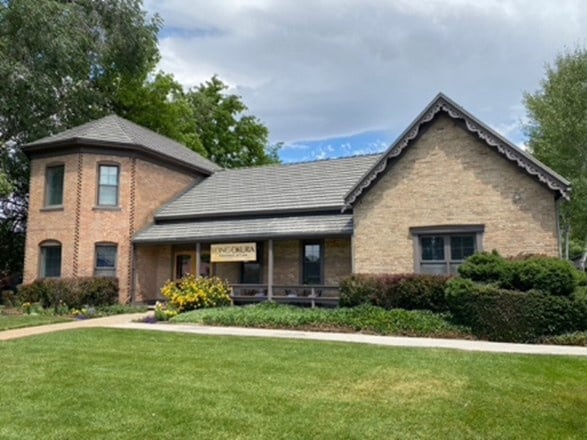
National Register of Historic Places
1981 Murray-Holladay Road
The David Branson Brinton House is significant for its association with the lives of three locally prominent historical figures: David Brinton, David Branson Brinton, Sr. and David Branson Brinton, Jr., all of whom played important roles in the growth and development of Holladay, Utah. The three were noted as religious leaders but involved in a variety of community-building roles. The Brinton Home is one of the oldest surviving structures in the Holladay area and is architecturally representative of the pioneer period. The home has undergone additions but the historic portion is essentially intact.
Following the arrival of the first party of Mormon pioneers to the Great Salt Lake Valley in July 1847, small groups of settlers were sent north and south of the city to establish other communities. The first permanent settlement made outside of Salt Lake City was Holladay's Burgh, (later Holladay) named after the founder, John Holladay, which was established on Spring Creek, a tributary of Big Cottonwood Creek, three miles north of the mouth of Big Cottonwood Canyon. Among the settlers of 1848-49 was David Brinton (1814-1878) and his family. The Brintons had historically been builders and blacksmiths. David Brinton was a well-known colonizer, missionary and church leader. He was sent on various scouting missions by Mormon leader , Brigham Young, and was among those who established Parowan, an important central Utah settlement in 1851. Brinton also investigated possible settlement areas near Fort Bridger, Wyoming. As an early pioneer of Holladay, David Brinton obtained lots five and six of the Holladay Field Plat of 1849. Hhe added several others properties and eventually controlled valuable commercial and agricultural land in the center of the community. A blacksmith by trade, David built a blacksmith shop on the southeast corner of 4800 South and lower County Road (Highland Drive) where the Cottonwood Mall stood between 1962-2008. On this same land he had a large farm on which he raised livestock, which provided meat and produce for the military at Fort Douglas.
Brinton was sometimes a controversial figure. He was once engaged in a dispute over whether a liquor distillery should be allowed to be built in the district. The distillery was subsequently built and “caused considerable drunkenness.” In 1870, citizens petitioned Brigham Young requesting Brinton’s removal as bishop (lay cleric). Three LDS Church leaders came to Holladay, met with the disgruntled faction, and convinced them to sustain Brinton.
The David Brinton house was built in at least two stages, beginning in the last 1860’s and ending in 1896. It features two distinctly different architectural styles or periods. In the oldest, central and eastern portions, some bricks taken from a wall are stamped “1869” and the patent date on box-locks is “1866,” perhaps indicating an original construction date earlier than 1877. The central part of the building is built upon a gray, granite foundation with a brick superstructure. The brick was not commercially produced, as it appears to be hand-formed and kiln-baked and is not uniform in shape. The brick varies in color from cream to light salmon. The western wing is two stories tall and features pressed dark salmon or red brick and pent corners on the front façade.
David Brinton’s son, Franklin Brinton, built a house for himself and his new wife, Alwilda Andrus Brinton (daughter of founder Milo Andrus) in 1877. The Brinton’s house at 4880 S Highland Circle was demolished in 2024. It was one of the oldest two-story adobe structures in Utah.
Source: United States Department of the Interior National Park Service National Register of Historic Places, David Brinton House
3. Santa anna Casto House (approx. 1870)

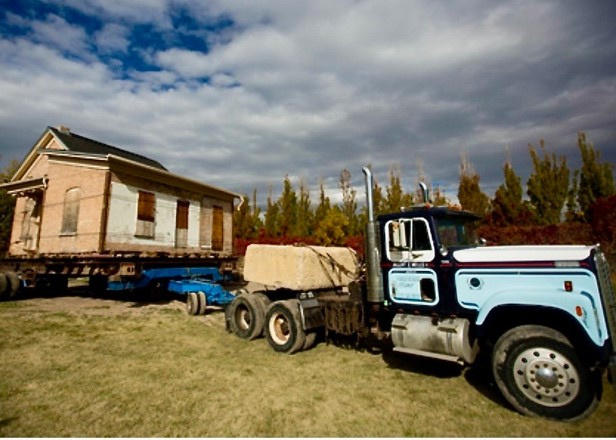
National Register of Historic Places
Holladay City Park
4580 S. 2300 E.
Built around 1870, the Santa Anna Casto house is one of ten buildings in Holladay built during the community's original period of settlement. These buildings were constructed between 1860-1875 and represent the earliest architectural styles found in Salt Lake Valley. Associated with the pioneering efforts of the Mormon people, these homes exemplify the vernacular architecture popular in Utah during this period. The Casto house, a one-story square-cabin with a rear lean-to extension, is important because it is one of two unaltered and well-maintained examples of mid-nineteenth century vernacular architecture in Holladay.
Santa Anna Casto was born May 7, 1850, in Council Bluffs, Iowa, the son of William and Racheline Casto. The Casto family resided in Nauvoo, Illinois for several years before conflict with the state drove the group westward to Utah. William Casto served in the Mormon Battalion and named his son after the Mexican general, Santa Anna. The Casto name itself is probably French, being anglicized from "Cousteau." William Casto made several trips to the Salt Lake Valley with the advance companies in 1847 and 1848 before bringing his family west in the summer of 1851. The Castos were among the first families to settle the Holladay area, building a house within the first Holladay fort. As Santa Anna grew up, the population was slowly spreading out from the original town site, and he took his new family to the southeast to establish a residence on what is now Casto Lane. Here Santa Anna built a new brick home around 1870 and started Casto Orchards, which became famous in the area. He is also remembered as a fine floriculturist, and the Casto family name has become locally synonymous with ornamental flower gardens. Santa Anna Casto also took part in the establishment of the Big Cottonwood Upper Canal Company in 1877 and served as water master in the area for 16 years. He was bishop (lay clergy) of the Big Cottonwood Ward from 1905 to 1911 and died in 1914.
The Casto house was moved from its original site on Casto Lane to Murray Holladay Road, then moved a second time to Holladay City Park.
Source: United States Department of the Interior National Park Service National Register of Historic Places, Santa Anna Casto House
4. GEORGE AND ELIZABETH TAYLOR BOYES HOUSE (1884)


4766 Holladay Boulevard
Built by the George Boyes Family, this two-story adobe brick house is coated with gray stucco. While its present appearance is rather plain, this building was once a vibrant Victorian home featuring a broad porch decorated with elaborate gingerbread scrollwork. George was born in Yorkshire, England in 1794, and Elizabeth Taylor Boyes was born in 1819 in Westmorland, England. They married on the trip westward from Winter Quarters in Nebraska, which was established under the direction of Brigham Young. George was one of the first Mormon bishops (lay clergy) in the Cottonwood-Holladay area. He helped build the fort intended to protect Holladay settlers from the Native people of the area, although it was never needed for that purpose. George died in 1874, and this house was finished in 1884 for Ann. After George died, their son, Joseph, lived in the house with Ann.
Granddaughter Leona Andrus Taylor remembers this of her grandmother:
“In Grandmother’s home it was necessary to do many tasks that fell to the lot of pioneer women. Flax was raised on the farm from which thread was spun. Her daughters Elizabeth and Sarah Leonora did most of that spinning. The girls made their own dresses and wore them until the skirt was thin at the back, when back was turned to front and the dress used as a school dress, and a new Sunday one made. Grandmother was a splendid housekeeper. Despite her delicate health, they had nine children. She ultimately directed much of the household activity from her couch, and it was carried out to her liking. The children each had a nail for their clothes and in the evening before they retired their clothes were hung on the nails with the shoes, heel touching the wall, underneath them. Before her daughters or hired help could sit down to a meal the stove must be in order as well as the worktable.
… She liked her children to have nice things and loved to get them pieces of jewelry to wear. She was very hospitable and entertained the authorities of the LDS Church and their wives a great deal when they came to Big Cottonwood. Never a friend came in that she did not send one of the children to get a pan of chips and refreshments were served them.”
Elizabeth Taylor Boyes died in 1909.
Source: Collections.lib.utah.edu George A Boyes House, Ancestry.com, Familytree.com
Sandy Meadows, Chairperson Holladay Historical Commission
5. DAVID McDONALD HOUSE (1894)
National Register of Historic Places
4659 Highland Drive


The McDonald House is a two-story structure, constructed of brick and adobe manufactured on the property at a site just south of the house. The house originally consisted of eight rooms. Although disguised by the projecting section on the right of the façade, the plan of the house is basically symmetrical, the only decorative details are the raised segmental arches of the front windows. A privy was located behind the house to the east. The McDonald House is significant for representing the values of a middle-class family striving to establish themselves in pioneer society. The simple dignity of the McDonald House suggests the residence of a hardworking, upwardly mobile, skilled tradesman. Other than the raised segmental window arches, the house has few stylistic details, and the central hall plan is a remnant of earlier vernacular architecture. Located away from the center of Salt Lake City, it documents the scattered pattern of settlement in the outlying areas of the Salt Lake Valley. Although the Mormon Church dominated settlement patterns in Utah, the opening of a federal land office in 1869 brought the scattered homestead pattern to the state. The McDonald House exists today in the midst of later twentieth century development, a landmark of early domestic architecture in the Greater Salt Lake Valley. The house has been carefully restored.
The architect-builders were the owners, David and Arabella McDonald, who lived in the building until their death in 1924. Both were immigrants to Utah in 1869, he from Scotland and she from Northern Ireland. Both were 41 when the home was constructed, a measure of their success in Utah. David McDonald had been educated in Scotland and apprenticed as a blacksmith and millwright for five years. He and Arabella married in the Salt Lake Endowment House in 1874. They remained supportive of the Mormon Church and its various programs, although his ambivalence about the Mormon Church was cause for comment. His membership in the Liberal party, and the broad selection of titles in his much-loved library suggest his distance from the mainstream of Mormon thought and practice. The McDonald blacksmithing business, located only 50 feet from the McDonald home, prospered over the years. His increasing stature in the business community led to McDonald's increasing involvement in politics. With the introduction of national political parties into Utah, he quickly became established as an active Republican. At the death of both parents in 1924, the home passed into the hands of other members of the family and eventually was converted into a rental property in 1966.
Source: United States Department of the Interior National Park Service National Register of Historic Places, David McDonald House
6. Morton A. CHEESMAN (1912)
National Register of Historic Places
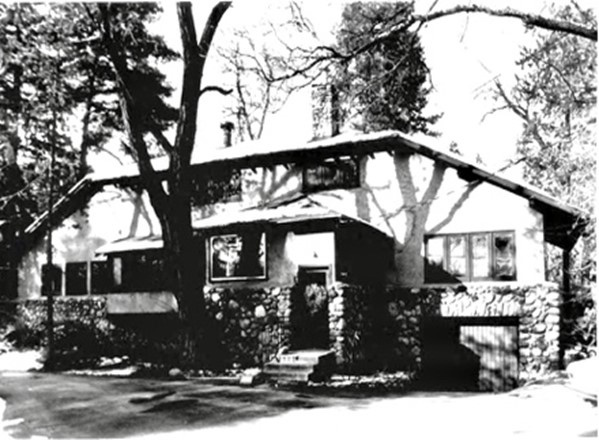

2320 Walker Lane
Morton A. Cheesman was born in 1889, a son of Martin and Mary Ann Walker Cheesman. He began working in 1910 as a treasurer for Walker Brother Dry Goods for most of his tenure in this house. He was also president of Cheesman Auto Company.
The Mort Cheesman House was built in 1912-13 on eleven acres of property originally owned by Cheesman's maternal grandfather, Joseph R. Walker, a Salt Lake banker and businessman. The settlement of the Walker estate resulted in Mary Ann Walker Cheesman receiving the property. Mary Ann deeded the property to her son, Morton, who hired Ware and Treganza to build his house. Mary Ann hired the same firm to build a house adjacent to his house. The property was deeded back and forth from Malcolm to his mother, and also to Malcolm Keyser. The reason for the property changing hands is blamed on the stock market crash of 1929. In 1932, the Malcolm Keyser family moved into Mary Ann’s house. The Mort Cheesman house remained vacant from 1932 until 1945 until Malcom Keyser, Jr. sold the house for $1 to his sister, Helen Keyser, and her husband George McClure. The McClure family continues to live in the house.
The Mort Cheesman house is an outstanding and unique example of a few large-scale Craftsman homes in Utah and is one of two designed by Salt Lake architectural firm Ware and Treganza. It is a distinctive example of the Craftsman style due to its single axis orientation, and its unorthodox point of entry. The combination of stucco and cobble rock as building materials is not common in Utah, especially in large homes as . iIt was more often reserved for use in Craftsman Bungalows. Craftsman elements which tie the house together include: a low-pitched roof; ornamentation created by the use of natural materials such as exposed rafters and purlins, bands of casement windows, and cobble rock for the base and chimneys; the use of leaded glass in some windows; and the combination of materials, stucco and cobble rock, to create visual interest rather than relying on the application of ornament to serve that purpose.
Source: United States Department of the Interior National Park Service National Register of Historic Places, Morton A Cheesman House
Interview with Marjorie McClure 3/12/2024
7. MILO ANDRUS JR. HOUSE (1913)
4917 Holladay Boulevard


Milo Andrus Jr. and his family played a significant role in the settlement of the Cottonwood-Holladayburgh area of Salt Lake County. His father, Milo Andrus Sr., was a prominent early Mormon pioneer who knew Joseph Smith and who later joined the first pioneer companies in settling Salt Lake. The Milo Sr. home, previously located in Murray on State Street, has been moved to This is the Place Heritage Park for preservation. Milo Andrus Jr. and his wife Elizabeth Boyes had 13 children, aII of whom survived. Many of his children and grandchildren settled and constructed homes in Holladay. Of his sons, George, Joseph and Willard built a row of homes at 4871 Holladay Blvd, 4877 Holladay Blvd (now demolished), and 4885 Holladay Blvd. Early records of property transactions and histories written of Holladay often include accounts of the Andrus Family and their influence.
Milo Jr. was born in England when his father served a mission there. He later lived with many mothers as his own mother died. His father had 11 wives and 57 children. Milo Jr. was with the party in the canyon when Johnston’s Army invaded Utah. He accompanied Emma Lucy Gates (one of Brigham Young's daughters) at the celebration when the monument was placed in Parley's Canyon. He was known as a farmer with considerable land and spent 30 seasons assisting fellow farmers in threshing and harvesting. He and a friend and church associate, Santa Anna Casto, planted the first peach and other fruit trees in the Holladay area. George, Milo's son, later dealt in the growing and selling of fruit and chickens. He died in 1938.
The house is a large two-story bungalow with an intersecting hipped roof and four dormers. It is built of soft red brick and sits on a base of rusticated concrete blocks. There is a pronounced bay window on the north side of the house. It has several leaded glass windows and colored stained-glass panels.
Milo and his wife lived in the house until 1938 when it was sold to their son George who turned it into apartments. When the Gustafson family purchased it in 1975, it was converted back to a single-family home and painstakingly restored it to its original condition.
Source: Nomination to United States Department of the Interior National Park Service National Register of Historic Places, Milo Andrus Jr. House. (Nomination not completed.)
8. WILLIAM AND ANNIE LIVINGSTON HOUSE (1917)

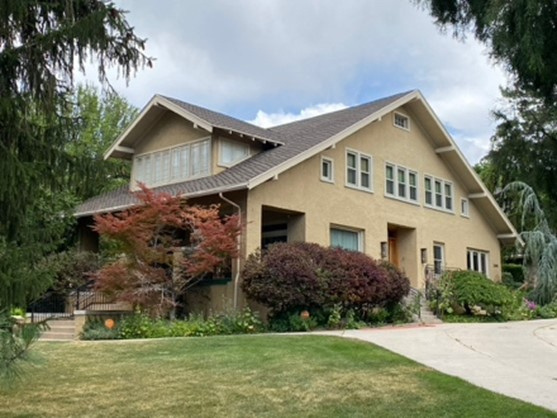
National Register of Historic Places
2491 Valley View Drive
The William and Annie Livingston House was constructed in about 1917. It is a gabled 1 ½ story Craftsman-style bungalow with a concrete foundation and brick walls covered by an exterior finish of pebbledash stucco over the entire body of the house. The ordinal primary façade on the west includes a typical bungalow porch running the width of the house, which shelters a pair of doors in the center flanked by two large windows, each with an upper section of leaded glass. The porch on the west is perched quite high, which gives the house a commanding presence when viewed from Holladay Boulevard. It is surrounded on three sides by numerous large evergreen trees, many of which are older than the house itself.
This house represents the early beginnings of suburbanization in Salt Lake Valley. Prior to this time, some of the wealthy Salt Lake elite had built large summer homes in the Holladay area, but the Livingston House represents a trend for members of the upper-middle class to build homes in the area with the intent of working in the urban core while living in a rural setting. While the real impact of suburbanization would not be evident until post-war suburbanization, the Livingston House illustrates that the trend had its beginnings in a much earlier time.
The Livingstons chose to build their substantive house in the relatively remote rural community of Holladay, even though William Livingston was a prominent Salt Lake businessman and maintained his office in the downtown business district. Their decision to build a Craftsman-style bungalow further illustrates the desire to create a retreat from complex modern life. While many Craftsman-style homes were built in Salt Lake, none could achieve the Arts and Crafts ideal of connecting with nature the way the Livingston home did, set on a large piece of property surrounded with pine trees in the rural community of Holladay. Ironically, the achievement of this isolated, simple life in the setting of nature was dependent on the complex hubbub of commerce in the business district of Salt Lake City and on technological advances in transportation.
Like the Livingstons, all the subsequent owners of the house into the 1950s chose to live outside the urban setting of Salt Lake City, despite the fact that each made a living working in the downtown business district of Salt Lake City. The house is important in the history of Holladay as a marker in the long transition from an agricultural community to a suburban municipality. It is also significant in the history of Salt Lake City as an indicator of a cultural attitude shift towards a preference by those who were tied economically to the urban center to live outside the urban area if they could afford to do so. Furthermore, while this property is most closely tied to the history of the Salt Lake Valley, the trends of suburbanization of rural communities, as well as the upper and middle-class exodus from the urban core are themes that played out in communities across the United States in the 20th century.
Source: United States Department of the Interior National Park Service National Register of Historic Places. Livingston, William and Annie, House, Holladay, Salt Lake County, UT
9. ROSS HAME (1922)
National Register of Historic Places
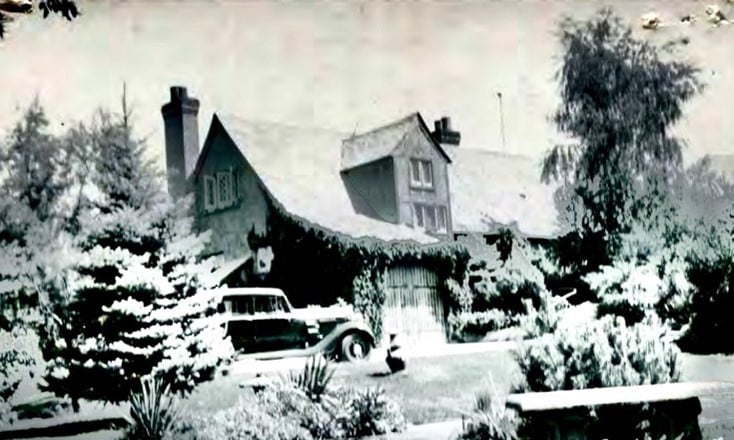
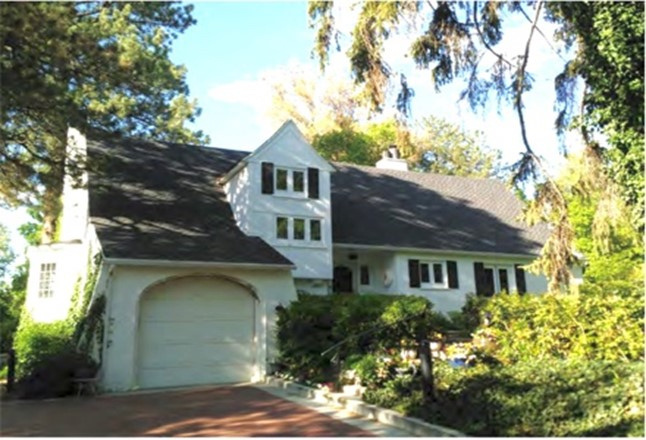
4769 S Holladay Boulevard
Ross Hame, also known as the William Harvey and Sarah Seegmiller Ross House, was constructed in 1922- 23. The house and its grounds are significant as they represent a rare collaboration between three important Utah architects; Walter Ware, Alberto Treganza, and Georgius Cannon. Secondly, although such estates continue to shape Holladay’s Twenty-first century identity, very few of Holladay’s first-generation estates have survived excessive alteration or demolition and even fewer have retained much of their historic landscape. In the case of Ross Hame, however, the house, its adjacent stable/caretaker’s cottage, and much of its landscape convey the original intent of their designers and grant passersby a rare glimpse into Holladay’s rural past which contrasts greatly with the city’s twenty-first century redevelopment.
William Harvey Ross, the man who commissioned Ross Hame, was a descendent of early Utah pioneers who had helped settle Provo. His father, Thomas Ross, established a sugar beet processing company which became The Gunnison Sugar Company. Upon the death of his father in 1919, Harvey Ross became president of Gunnison Sugar. He initially faced financial failure in managing the company, but received unexpected financial relief from William Wrigley Jr., the chewing gum industrialist. By purchasing the Gunnison Valley Sugar Company, Wrigley put Gunnison Sugar and Harvey Ross in the black. With his professional and financial situation secure, Ross started constructing his dream home the following year. Ross purchased several acres of land from Anders and Augusta Peterson, Scandinavian immigrants who settled in Holladay in the late nineteenth century. Shortly thereafter, Ross commissioned Ware, Treganza, and Cannon to create plans for Ross Hame which, according to the firm’s own calculations, cost approximately $20,000 ($371,000 adjusted for inflation) to build. Harvey Ross would likely not have had this $20,000 if not for William Wrigley Jr’s acquisition of Gunnison Valley Sugar Company. As a result, it has been said that Ross Hame was “built” from chewing gum.
Ross Hame was constructed in 1922- 23. It is a three-story Tudor Revival villa covered with heavy, roughcast stucco. The stucco finish is interspersed by false half timbering on the stair tower rising from the house’s front or west-facing façade and on a dormer rising from the house’s back or south-facing roof. This half-timbering together with the homes flared rooflines, leaded glass windows, and park-like setting, grants Ross Hame a storybook English cottage feel. Currently, Ross Hame’s roof is covered in asphalt shingling designed to imitate slate. Originally, this roof was covered in cedar shakes, a feature that reinforced the house’s storybook character. Spring Creek flows through Ross Hame’s grounds, which include many early landscape elements including waterfalls, benches, bridges, lawns, and a tennis court. The grounds also feature a caretaker’s cottage which is located directly behind, or east of the main house. The two-story cottage, originally built to serve as a stable and carriage house, features a roughcast plaster exterior.
Source: United States Department of the Interior National Park Service National Register of Historic Places, Ross Hame
10. HAROLD W. AND EVELYN BURTON HOUSE (1923)
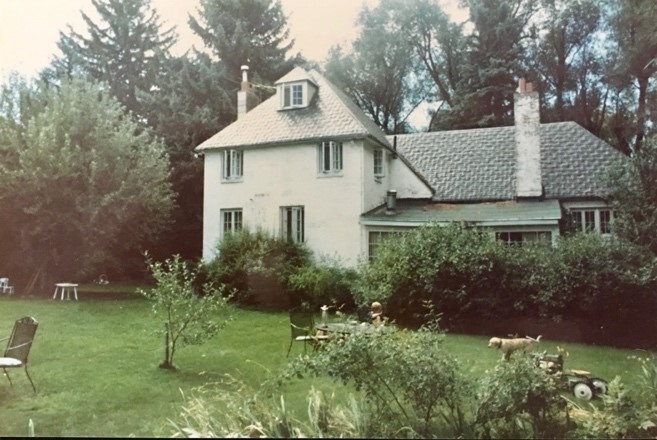

National Register of Historic Places
2195 Walker Lane
The Harold W. and Evelyn Burton House was constructed in 1923. The house was designed by and was the primary residence for Burton, his wife Evelyn, and their four children. Harold Burton was a prominent architect in Utah at the time. His wife, Evelyn, was active in developing Gilmer Park Subdivision, now listed as a part of the Gilmer Park Historic District. She was also one of the principal owners of that project. Burton’s firm, Pope & Burton, designed several significant and iconic buildings in Utah and North America. They designed the Memorial House (1926), the Ezra Thompson Building (1924) (also known as the Tribune building), Holy Trinity Cathedral (1923) St. Paul’s Episcopal Church in Salt Lake (1917), Laie Hawaii LDS Temple (1919), Cardston Alberta LDS Temple (1923), Wilshire Ward LDS Chapel (1929), and the Oakland California LDS Temple (1964). He moved to California in 1930 where he continued to design many temples and meetinghouses for the LDS Church in the U.S. and Canada during his prolific career. He ultimately moved back to Utah and became the Chief Supervising Architect for the LDS Church, so his influence is felt worldwide in the buildings he designed and projects he supervised. Although much of his work of importance continued after he moved from here, this house is the best preserved of his residences in Utah, the others having been impacted by a loss of historical integrity. For this reason, the Harold Burton House is significant and eligible for inclusion in the National Register of Historic Places.
The Burton House is a period cottage residence with a cross-wing floor plan, built in the French Eclectic style. The smaller wing is one story with a clipped gable roof. The larger wing is 2.5 stories with a hip roof. The roof was originally shingle, then copper was overlaid in about 1940. When the copper failed after 50 years, slate was installed on the roof. It complements the garage roof, which remains copper. The walls are oversized terra cotta-colored brick, laid in a Flemish bond pattern. The above photographs are the rear of the house. The primary façade has a recessed entrance with the original heavy Tudor-arch oak door. The Tudor arch theme is repeated in the high ceiling of the great room, as well as in the interior archways of the house. A row of French doors extends west of the entrance and opens onto a terrace. In two of the second story bedrooms, French doors open onto small wrought iron balconies. The house retains its original floorplan, as well as original windows, fireplaces, radiators, and hardware. The knotty-pine attic was called a “gun and tackle room” and a caretaker’s apartment is over the detached garage.
Source: United States Department of the Interior National Park Service National Register of Historic Places, Harold W and Evelyn Burton House
11. DRAGE HOUSE (1920)


4648 S Locust Lane
The Drage family have made this their home for four generations. Built in 1920, this 2-bedroom bungalow was owned by Annie Mae Watford and Ephraim Moroni Drage. The original property included an apple orchard and large farm where the Drages grew potatoes and food for the family. It also had a silo on the south side of the house and a large walnut tree on the east side. The ponderosa pine that still stands is one of the tallest in the valley.
Annie and Ephraim Drage had nine children. At one point in their life, they set up a hamburger and hot dog stand where the back field of Olympus Junior High is now. Kids coming home from school could stop by and get some lunch and a drink. Eventually, they built the house to the south and at one point, two Drage sisters lived next door to each other. Eva Mae Drage and William Taylor lived in this home and Vivian Drage and her husband Ronald Reynolds lived next door (in the red brick home). Eva and Bill, the grandparents of current owner Natalie Taylor, added an extra bedroom and updated the home significantly. The basement included a coal room and the house was heated via a StokerMatic coal furnace.
The Drage family has continually invested in this home and this property in the hopes that it will remain in the family for future generations.
Source: Interview with owner 4/1/2024
12. FENNO CASTO HOUSE (1943)
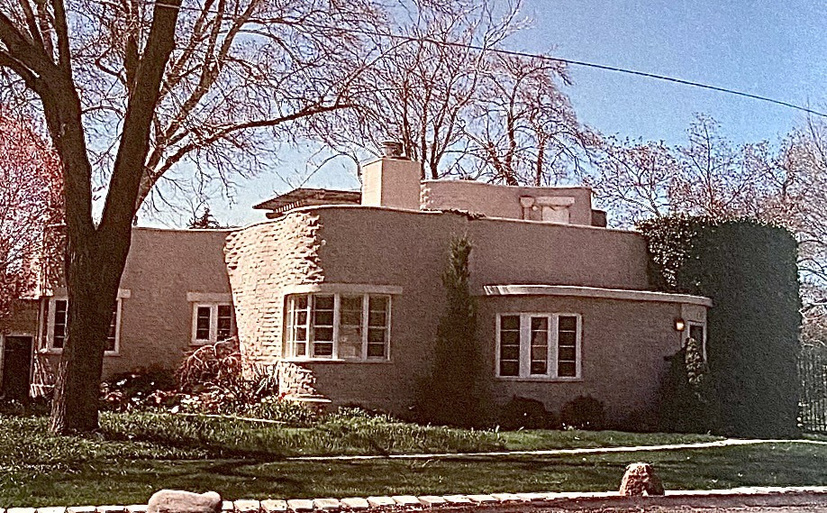
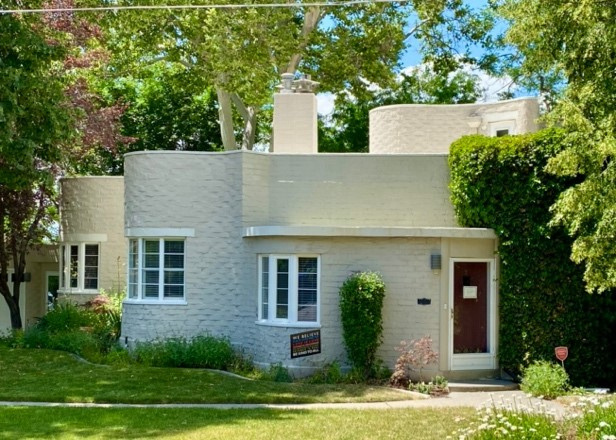
4864 Wander Lane
The County Assessor’s office lists the building date in 1943, but Fenno Casto and his wife Amy Mower Casto began building this house around 1933, They raised four children here, born between 1932 and 1946. Fenno’s daughter, LaJuan remembers that her father’s “absorbing and interesting hobby would be the construction of their home which began with the design obtained in a dream of Fenno’s. It seemed that his wife had him in a corner, so he decided that their home would be one built without corners.” The work involved in their home was spread over about a 22-year period, commencing in the 1930’s.”
Initially the dwelling was an old, small, two-bedroom house built of used lumber. They decided to try to lift the house, dig a basement underneath, and put a rock foundation around it. They spent two years doing this, mostly by hand, sometimes with a borrowed scraper and horse and hand jacks to raise the house.
After LaJuan was born in 1934, they needed more space, so Fenno started digging the rest of the basement, again by hand. They had to walk across planks over the basement to get to the kitchen. When they started to create the cement basement walls, they could only afford to buy one sack of cement a week. Fenno built a form that would hold that much cement and mixed it. Each Saturday they poured a section of wall. During the week he would strip the section, rub it down, and form the next section.
Their church congregation planned to build a new chapel. Fenno got the idea to make cement bricks by hand. After the building was completed, there were a lot of misshapen bricks that couldn’t be used, so Fenno bought them. He realized these bricks could not be used to build a straight line, so he designed the house with curved walls. After he had the basement walls poured, he designed the foundation to go in curves to use these misshapen bricks. He built the foundation around the existing house, so when the house was in the way, he’d rip off a few boards and leave portions of the house exposed. Very often the whole room would be exposed when he pulled off a side of the house in order to put the bricks up.
Amy said they lived in a partially open house for quite a few years. They worked nights and Saturdays and Fenno’s job as a surveyor for the Utah Road Commission often took him out of town. They never worked on Sunday. During their children’s early years, Amy and Fenno tried to make it as nice as possible for them to have their friends over, even though the home was not finished. There were many parties held in the living room with the tool bench and saw covered over with sheets. The girls would spend days before the party, with the help of their friends, decorating the room so it would look nice, and they would not be embarrassed.
It took several years to get all the curved bricks laid and cement partitions in the house ready to put the roof on. They started taking the old roof off in the summertime and finished demolishing it in August. The house had a flat roof and, like all the floors, was made out of cement. It rained nearly every day. Amy cooked their meals holding an umbrella over herself and the stove.
Winter set in and the roof wasn’t complete. They slept upstairs and many mornings they got up, shook the snow off the top of their bed, and ran downstairs to get dressed.
The kitchen was the first part of the house to be completed. Then they started upstairs so that they could have a bedroom for the girls. Colleen and LaJuan were about twelve and fourteen, so it would have been around 1946. They were working upstairs in the early springtime, and when they began to see that it was taking shape, they decided to try to finish it for Easter as a surprise. Amy remembered, “I think one of the biggest thrills of their life and of ours too was hearing the squeals of delight when the girls opened the door into their bedroom and saw a beautiful, finished room that was all their own after living in all the messes they had lived in during the previous years of their life. It was very important to Fenno and me to reward the girls for their tolerance and patience by having their room completed first.”
Source: https://www.familysearch.org/tree/person/memories/KWC4-V1Z
13. HOLLADAY CITY HALL, FORMERLY HOLLADAY ELEMENTARY SCHOOL (1928)
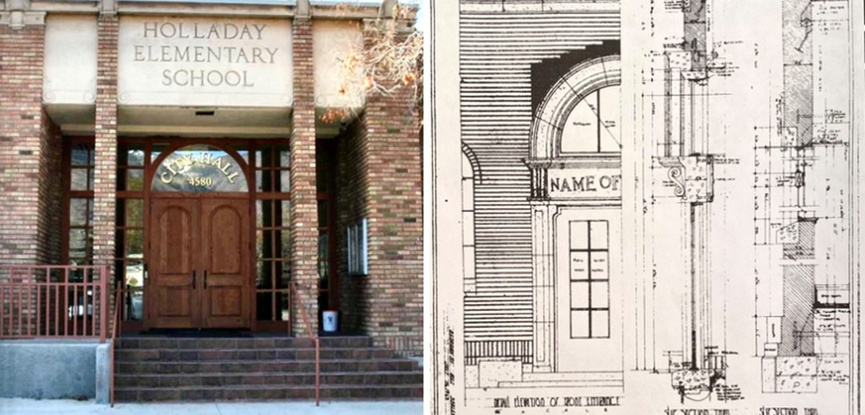
4580 S. 2300 E.
Holladay City Hall, formerly Holladay Elementary School, was constructed in 1928 following designs drafted by Ashton and Evans, an important Utah architectural firm which operated from 1923-1928 (the firm continued as Ashton, Evans, and Brazier from 1929-1963). It was built in what had been an apple orchard, at a cost of $25,565. Paul I. Paulsen was the builder on this project (as well as on the Harold W. and Evelyn Burton House listed above). The building has Art Moderne/Art Deco detailing in cast stone. It features raked orange and brown brick placed in a common running bond pattern.
Several additions to this building were added in the ensuing decades, each of them designed by Young and Hansen, another prominent Utah-based architectural firm which existed between 1916-1960. These additions included a four-room, 1936 Public Works Administration project on the building's north end. A second was a four-room 1946 addition on the building's south end. In 1952, a multi-room was added on the building's south end and an entrance was added that is now the main entrance for City Hall. At some point in the mid-Twentieth Century there was a swimming pool on the west of the building. Former student Lynn F. Newman remembered, “They pulled down the trees to make room, with just horses and manpower. They left the trees lying there, and the boys in the third and fourth grades moved them by hand to make a ball field.
The initial Holladay Elementary School was commissioned as part of a Granite School District-led effort to bring quality education to children living throughout Salt Lake County. Subsequent additions made to this school track Holladay's suburban growth. Early 20th-century attempts to link Holladay to Salt Lake County's streetcar network, followed by Utahn's embrace of mass-produced automobiles, were both key factors in Holladay's transformation from a sleepy farming and summer resort village into a family-filled bedroom community known for the quality of its schools, among other things.
The school closed in 2002. Holladay City chose to purchase and renovate it, because, according to then Holladay City Manager Randy Fitts, “It has some historical significance. That’s the main reason the city wanted to purchase it – to preserve that.”
Source: Alan Barnett, Granite School District
Deseret News May 20, 2002 and 10/212005
David Ammot, former director Preservation Utah
14. HEALTH INDUSTRIES INC. OFFICE BUILDING (1971)

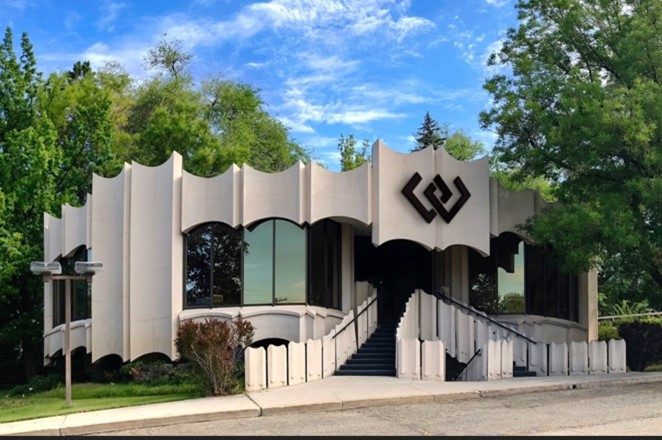
4535 S. 2300 E.
This building was designed by Joseph H. Young, of Young & Jones Architects. It was constructed in 1971 for Health Industries Inc., which was apparently the parent company of European Health Spas Inc. The president and founder of the company was Robert L. Rice, who was a health club pioneer and philanthropist (Rice-Eccles Stadium at the University of Utah.) Ken Melby was vice president of the company and a health spa developer. European Health Spas was reportedly the largest health club chain in the U.S. in the 1970s. Rice sold European Health Spas in 1974, but continued to be involved in a variety of health club and spa business ventures. The company apparently outgrew this building as the health-spa industry prospered. By 1981 the building was occupied by Clark Financial Corp., a financial consulting business. It is currently occupied by Windermere Real Estate.
Source: Utah Dept of Cultural & Community Engagement #182474
Virginia Ulibarri, owner of AMATA
15. JANE AND RALPH REYNOLDS HOUSE (1958)

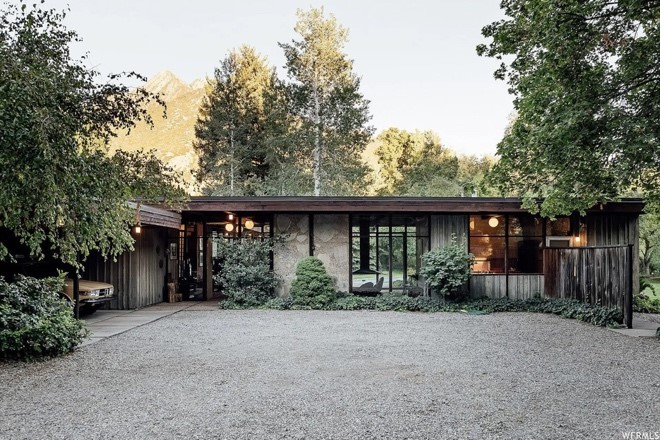
4979 Cottonwood Lane
This Japanese-inspired post-and-beam-style house was built in 1958. It was designed by Utah architect Stephen MacDonald, whose designs “limited separation between the indoors and outdoors rather than creating a protective barrier between them.” To that point, the L-shaped rear facade of this house is floor-to-ceiling windows facing onto the gardens. The bedrooms each have sliding doors to the exterior. Moveable shoji screens are placed wherever privacy is needed. A ceiling mounted fireplace divides the dining room from the living space and, when the sliding doors are open, one is as much outside as inside.
The house is constructed largely of rock, wood, and concrete, with repetition of materials and lines. The floors are square concrete slabs, and in the living room there are concrete slab walls embedded with the same stone as the exterior, again, making the transition between inside and outside more seamless.
MacDonald oriented the angle of the house on the property to maximize natural heating and cooling. The shoji screens allow for additional control of sun or shade. In the winter, the low sun slants in through the big picture windows and warms the rooms and floors. In the summer, the rooms are shaded by the eaves, keeping the rooms cool. Additionally, if the doors are kept open at night to capture the cool Holladay air, then closed in the morning, the house stays cool all day.
After the showing at the 1955 Parade of Homes in Holladay (now honored as the Parade of Homes Lakewood Site Historic District) MacDonald designed this house in the woods on Cottonwood Lane. Ralph and Jane Reynolds found the home for sale in the summer of 1958. They were already friends with the architect and had considered asking him to design a home for them, then here it was! They recognized what an architectural treasure it was and fell in love with it instantly. Ralph was a graphic designer, while “Jane’s art practice was the environment she created with her garden and home.” They lived there for the rest of their lives.
The family remembers the indoor-outdoor design as being restorative, giving them a sense of connection with the natural elements.
In 2019, the house was purchased by a neighbor, who is retaining this timepiece’s original design.
Source: Dwell Magazine, This Tranquil, Japanese-Inspired Midcentury Home
Interview, Reynolds family 3/30/2024
Cityhomecollective.com Cottonwood Lane, Hand of Mod
Photo: Reynolds family
16. LEONA GUSTAVSON HOUSE (1956)

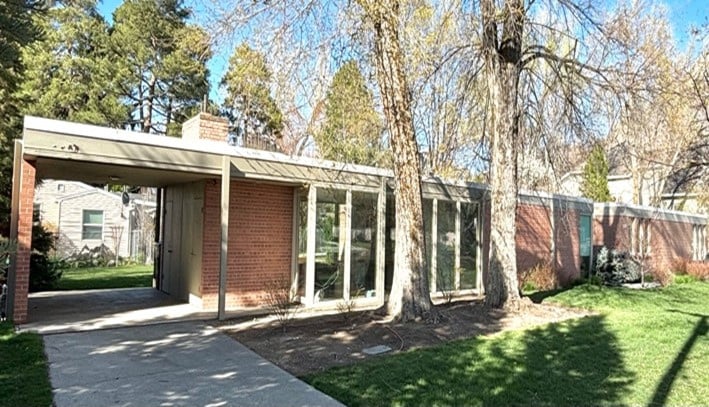
1989 Pheasant Way
Dean Gustavson designed and built this house and the following two houses on Hedgewood Court. It is the first of three of the same basic design.
“As one of the area’s most precise and articulate exponents of modernism, Gustavson is also its defense counsel. Is modernism cold and austere? Not at all, contends Gustavson. Selected use of materials, color and space can make modern architecture as ‘warm’ as any of the traditional idioms.” Asked if he thought there was a regional identity, he said, “Nuts. Bricks are made the world over. Steel is made the world over – and at Provo, too Concrete in the U.S. is just like the concrete in Mexico. And what ‘indigenous’ materials does Utah have? Granite and sagebrush. If there is to be a so-called regional architecture, it will not be expressed in materials. Rather it will be manifest in the form. The building, for example will be a rephrasing or a counterpoint to the spires of the Wasatch Front.” (The Salt Lake Tribune 1/8/1961 p. 38)
This house was built specifically for his parents, Leona and Ernest Gustavson. It was built in 1956.
Gustavson’s granddaughter, said that his influence was principally Mies Van der Rohe, and Le Corbusier. He studied architecture at UC Berkeley on the GI Bill after WWII. He was a fighter pilot in the war.
The current owners purchased the house in 2003 from the owner of an art gallery in Holladay. They understood the integrity of the house and intended to keep the floor plan original. But they ultimately needed more space for their family so doubled the footprint of the house. The addition mirrors the original design as closely as possible.
Source: Interview with Granddaughter Gustavson, 4/10/2024
Interview with current owners 4/10/2024
Photo: Granddaughter Gustavson
17. GUSTAVSON HOUSE (1959)
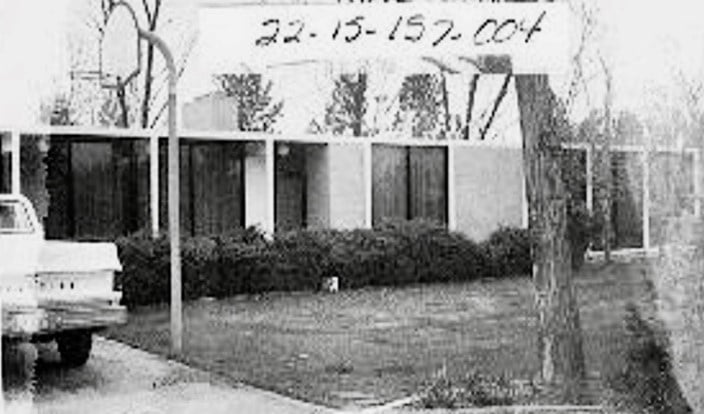
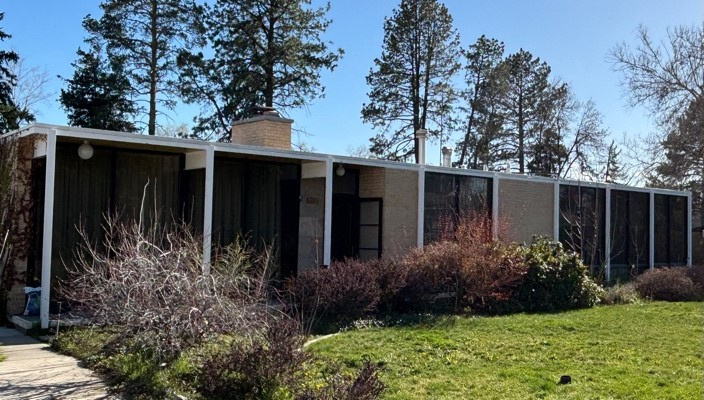
2062 Hedgewood Ct.
The Gustavson family still owns this house, designed by Dean Gustavson. He also designed the house right next to it at 2062 Hedgewood Court, as well as the house on the corner of Highland Drive and Pheasant Way. He is best known for his design of Skyline High School.
According the current Gustavson owner, “The property was an apple tree field – no home on the property before Parker and Lila Stoll bought it in late 1958. The home was designed by Dean Gustavson, but his sister Lila’s husband, Parker Stoll, built the home along with help from Parker’s US Navy Seabees. It was finished in early 1959. Parker was an expert craftsman and woodworker and cut all of the walnut wood currently in the home. Parker built the bomb shelter that now sits on my property, too.”
The current owner purchased this 1600 square foot home in 2022, a few months after her great-aunt Lila and great-uncle Parker died. She was determined to keep this home in the family so purchased it from her cousins.
The house is virtually in its original state, the current Gustavson owner said. “I love the home and wouldn’t change a thing about it. Not a thing. Many memories of lovely summer nights spent in both yards – BBQs and badminton (there also used to be more big apple trees everywhere.) We always had amazing Christmas nights at both homes, too, with big Swedish smorgasbord spreads.”
Source: Interview with Granddaughter Gustavson 4/10/2024
Photo: Salt Lake County Assessor
18. GUSTAVSON HOUSE (1957)

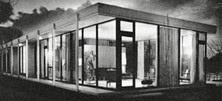
2044 Hedgewood Ct.
This 2350 square foot house was built in 1957, designed by Dean Gustavson. It won a national design award in 1960 in Architectural Records.
Dean and his wife, Barbara lived here from 1957 through his passing in 2011. His children all grew up there and spent countless hours with their cousins and aunt and uncle who owned the Gustavson house next door (more on that above).
Stoll built a bomb shelter on this property, and the one next door at 2062 Hedgewood, before the Cuban Missile Crises in 1962. According to his granddaughter, “that was the culmination of a great deal of nuclear missile ‘saber rattling’ in the very early Sixties. He built the observatory in the mid-Sixties after he and my father [his brother-in-law] took a four- week University of Utah course at the original Hansen Planetarium in Salt Lake City. He was very interested in astronomy.” The observatory was moved to a private owner in Central Utah.
The house is currently owned by someone who understands Mid-century design and has kept the house original, including the bomb shelter.
Source: Interview with Granddaughter Gustavson 4/10/2024
Photo Salt Lake County Assessor
The Parade of Homes Lakewood Historic District (2022)

The early ranch house was introduced in the 1930s and 1940s. During World War II, the shortage of construction materials, federal programs for war industry–related housing, and financing restrictions of the FHA caused these early ranches to be smaller, with modest amounts of traditional detailing derived from Colonial Revival styles. The demand for housing immediately after World War II resulted in a residential housing boom. Simultaneously, lending programs through the FHA discouraged implementing modernist designs resulting in a proliferation of small, traditionally styled ranch houses.
The Parade of Homes Lakewood Historic District is distinct from the much older Pioneer Era houses and the early Twentieth Century houses described above, in that these are part of a district of houses that retain integrity of location, design, setting, materials, feeling, and association that convey affiliation with the 1955 Parade of Homes. These Colonial Revival, Contemporary ranch style, and Contemporary-Modern homes are indicative of architectural housing types and styles that were popularized by both contractor-designers and architects in the 1950s. Of the original 17 homes constructed for the 1955 Parade of Homes, 11 retain integrity sufficient to convey their significance as a model home in the 1955 Parade of Homes. Prices for the homes started at around $15,000.
Source: United States Department of the Interior National Park Service National Register of Historic Places, Parade of Homes Lakewood Site Historic District
To understand how cutting edge these houses were, here is an account from the Deseret News, September 9, 1955:
“Members of the Utah Home Builders Assn will display 30 homes at the 1955 Parade of Homes representing the most modern trends in house design and construction.
Red Robin Homes, Inc. have built two remarkable homes from the roof down without benefit of nails. One called the “Red Robin Ten” … stands ever so proudly on pillars, scorning the traditional support of a foundation. Both are glued together but actually achieve integration through tension. These homes are wide open with patios and open courts comprising parts of the house area.
Stephen L. MacDonald, Salt Lake architect, conceived the construction technique applied to these homes and brought in a group of experts in interior decoration, structural engineers, and landscape design, to help bring them to reality.
The courtyard theme is featured prominently in the houses constructed by Melvin H. Jensen. “The Retreat” … The enclosed, yet open yards are highly representative of the latest trends in contemporary styling. The outdoor-indoor theme is predominant in most home building over the country today and the homes … show clever and unusual approaches to the problem of bringing the outside in and vice versa.
Almost every conceivable roof design is utilized in the construction of the Parade of Homes. Dale Howell’s “Sunny Dale” has a very modern butterfly roof with brick and fieldstone walls and an ultramodern plan.
Richard Howell’s “Geraldine” shows the traditional hip roof but pitched so low it won’t be recognized . . .
Though modern and even futuristic styling is predominant this year, there is a large group of provincials, smacking of the authentic. “The Dover” designed and built by Grant A Muhlestein is a near replica of the homes of Old England, featuring however, all the modern devices that make life comfortable.
Hyland Building Co. has constructed and painstakingly finished a New England styled home with an aroma of sea air about it: “The Connecticut Yankee.” Last of the provincial group is W Reid Horne’s California Colonial with its remarkable 29-foot fireplace wall, “The Dude.’”
LAKEWOOD HISTORIC DISTRICT HOMES
CLICK ON A HOUSE TO READ MORE ABOUT THE HOME



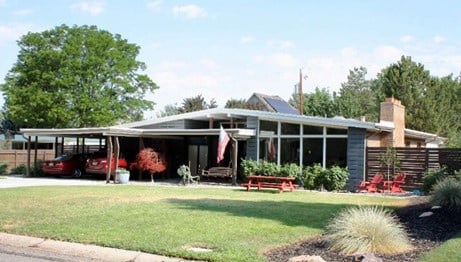

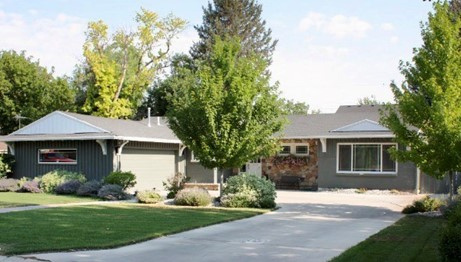

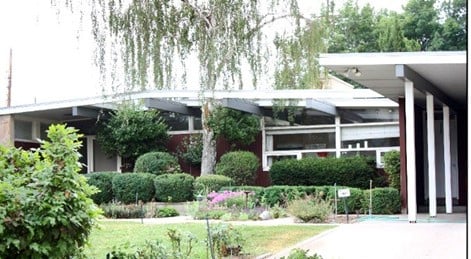
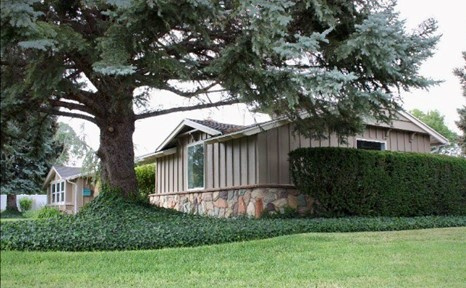
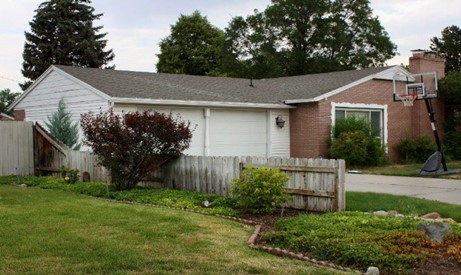
19. THE GERALDINE (1955)
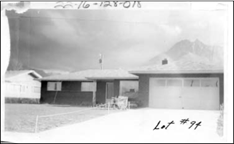

National Register of Historic Places
5483 South Fairoaks Drive
The Geraldine was constructed by Richard Howell Construction Company. It is a single-family, one-story, ranch-type house with a roughly L-shaped plan with a series of three stepped hip roof volumes. The roof is a low pitch cross-hip roof described as, “...a traditional hip roof, but pitched so low it won’t be recognized.” (Deseret News and Salt Lake Telegram). The exterior is clad in standard and stacked striated brick with sections of stucco on the south façade. The entry is set back, off-center, and sheltered below the middle hip roof section. A full-height, tripartite picture window is adjacent to the entry. A privacy wall extends from the southeast corner of the house toward the south. A brick interior chimney rises from the west slope of the middle hip roof.
Source: United States Department of the Interior National Park Service National Register of Historic Places, Parade of Homes Lakewood Site Historic District
20. THE DUDE (1955)
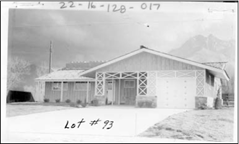

National Register of Historic Places
5473 South Fairoaks Drive
The Dude was constructed by W. Reid Horne and was referred to as a “California Colonial” with a 28-foot fireplace wall (Deseret News and Salt Lake Telegram). It is a one-story, single-family, L-shaped ranch type house with a cross gabled roof. The exterior is clad with stone veneer and board-and-batten siding. The eaves are open with exposed rafters and wood fascia closing the gable ends. The roof cladding is composite asphalt shingle. The garage bay retains the original paneled and diamond patterned overhead garage door. Both bays are bordered with a distinctive trellis of dimensional wood in an “X” pattern. A full-width entry porch shelters the entrance and two one-by-one, sliding windows. The broad 28-foot fireplace interior chimney rises from the ridge of the side-gabled wing. Four chimney pots with irregular spacing are atop the chimney.
The current owners purchased the house in 2012. They have made many improvements to the house to bring it into this century but have always loved the fact that it was part of the 1955 Parade of Homes. They want to showcase that, so it always took a great deal of time to plan every change to keep the look of the original home.
They recall a couple of years ago when an older woman, who was the original owner of the house, drove by with her family. They stopped, and Sarah invited them in for a tour. She pointed out changes, like added windows and an expanding dining room. The woman liked the changes. Sarah says that this house is like a Persian tent – tiny on the outside, but when you walk
inside it looks so large!
Source: United States Department of the Interior National Park Service National Register of Historic Places, Parade of Homes Lakewood Site Historic District
Interview with current owner 4/1/2024
21. THE SUNNY DALE (1955)


National Register of Historic Places
5465 South Fairoaks Drive
The Sunny Dale was constructed by Dale Howell as a one-story, single-family, Contemporary style house. The attached garage extends from the northwest corner of the house and creates a blunt L-shaped plan. The principal façade is clad in fieldstone and battened vertical wood panels. The side and rear façades are clad in brick. A butterfly roof shelters the north half of the house containing the garage and rear living space; a low pitch shed roof shelters the south living space. On the primary façade, fieldstone is the dominant cladding material on either side of the wood paneled entrance. The entrance is slightly recessed in the façade and set back behind the garage. The entry door is glazed with four horizontal panes. The rear façade predominantly consists of a full-height window wall with single-pane, fixed sash windows. Two sliding glass doors provide access between the interior and the curvilinear concrete patio; one is an extension of the window wall. A broad, brick chimney spans between the interior and exterior living spaces at the southeast end of the house.
Source: United States Department of the Interior National Park Service National Register of Historic Places, Parade of Homes Lakewood Site Historic District
22. THE COSMOPOLITAN (1955)
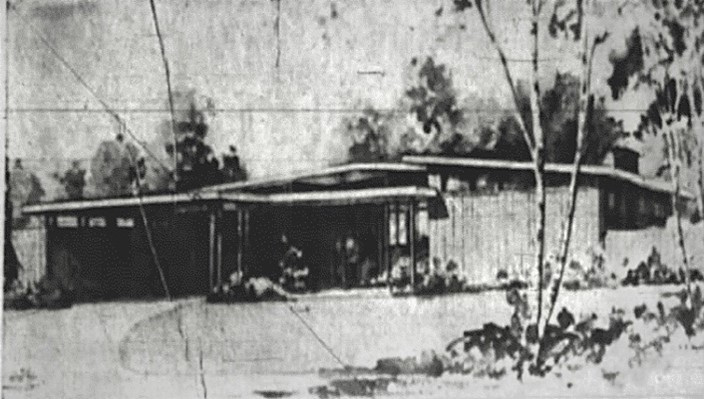

National Register of Historic Places
1649 East Lone Peak Drive
The Cosmopolitan was constructed by Stan Nelson Builders Supply Company. It is a one-story, single-family Contemporary style residence with an irregular plan. The principal façade is clad with horizontal, wood plank lattice mounted to furring leaving a void behind. The side and rear façades are clad in brick and wood panels. The roof is a broad, low pitch front gable and a flat roof extension from the primary façade sheltering the entrance and a carport. The entry is recessed into the primary façade below the center of the gable roof. The entry features a full height window wall of fixed sash, single-pane windows with the entry door offset to the right. The east wing of the house projects south and has a full height window wall into the gable. Though seemingly characteristic of the style, the wall was originally an uninterrupted wall clad in brick which is also characteristic of the private street facing façades of Contemporary houses. An exterior brick chimney is adjoined to the east eave wall and has three terracotta chimney pots.
The current owner is a former chairperson of the Holladay Historical Commission who loves Midcentury Modern design and feels lucky to have found this house. He was involved in the drive to get these houses listed on the National Register of Historic Places.
Source: United States Department of the Interior National Park Service National Register of Historic Places, Parade of Homes Lakewood Site Historic District
23. THE RED ROBIN (1955)
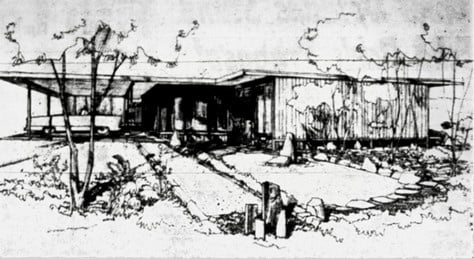

National Register of Historic Places
1635 East Lone Peak Drive
The Red Robin was constructed by Red Robin Homes Inc. It is a one-story, single-family, Contemporary house. It is irregular in plan with an attached garage projecting from the center of the primary façade. The house was designed by local Salt Lake architect Stephen MacDonald. It was described as standing “ever so proudly on pilars [sic], scorning the traditional support of a foundation... glued together, but actually achieves integration through tension” and “wide open with patios and open courts comprising parts of the house area.”
Stephen MacDonald, Salt Lake architect, conceived the construction technique applied to these homes and brought in a group of experts in interior decoration, structural engineering and landscape design, to help bring them to reality. (Deseret News and Salt Lake Telegram).
A photograph which accompanied the above newspaper report captured at the rear of the house during construction, illustrates the post and beam method. The exterior is clad with narrow vertical cedar slat siding with varying thickness to impart texture. The roof is ostensibly flat with a nearly imperceptible shallow pitch. It is supported with wide laminated structural beams which also act as fascia. Heavy bolts at junction points in the laminated beams indicate that the structure was not entirely joined with glue and tension.
The primary entry door is set back east of the garage and sheltered by the laminate beams that created a grid pattern brise soleil. The window orientation, configuration, and design are a demonstration of the importance of nature and its unobscured viewing from living spaces integral to the design philosophy. The courtyard itself is protected from street view with a semi-circular stucco privacy wall. This is a further tangible example of Stephen MacDonald’s intent to “bring the indoor out living into actual being”.
The house is currently owned by a family who was instrumental in the drive to get these Parade of Homes houses listed on the National Register of Historic Places.
Source: United States Department of the Interior National Park Service National Register of Historic Places, Parade of Homes Lakewood Site Historic District
24. THE CONNECTICUT YANKEE (1955)
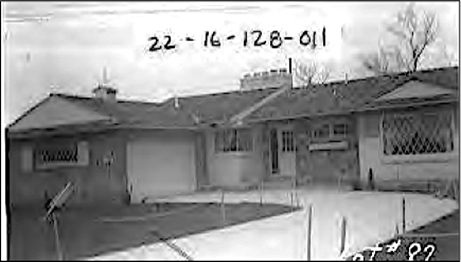

National Register of Historic Places
1623 East Lone Peak Drive
The Connecticut Yankee was constructed by Hyland Building Company and was described as “painstakingly finished New England styled home with an aroma of sea air about it” (Deseret News and Salt Lake Telegram). The house is a one-story, single-family ranch house with elements influenced by the Colonial Revival style. It is L-shaped in plan consisting of a wing parallel to the road housing the living space and a prominent front gable extension housing the attached garage. The principal elevation of the house is clad with board-and-batten above a brick veneer half-wall and stone veneer in the entrance while the side façades of the house are clad in brick. The cross gable has a low pitch and features blind gablet dormers which appear to pierce the roof as extensions of the primary façade. A pent roof continues below the gable end of the garage. A broad interior brick chimney rises from the roof ridge and contains five chimney pots.
Source: United States Department of the Interior National Park Service National Register of Historic Places, Parade of Homes Lakewood Site Historic District
25. BEL VISTA (1955)


National Register of Historic Places
1590 East Lone Peak Drive
The Bel Vista is a one-story, single-family, Contemporary style house constructed by builder W. Reid Horne in the Lakewood site. The house is irregular in plan with an attached garage extending from the west end of the house. The primary façade is asymmetrical with the front entry off-center between the living space and the attached garage. The exterior of the garage and the west half of the house is clad in vertically oriented wood paneling and the eastern half of the house is brick, as is the end-wall chimney.
The garage roof is parallel with the street while the north eave above the house is angled toward the northeast. Wood fascia rests on exposed beams in the gable ends and rafters are exposed below wide, overhanging, open eaves.
Source: United States Department of the Interior National Park Service National Register of Historic Places, Parade of Homes Lakewood Site Historic District
26. HOME #15 (1955)
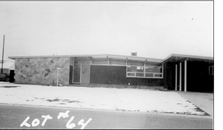

National Register of Historic Places
1650 East Lone Peak Drive
Home No. 15 is a one-story, single-family, Contemporary style house constructed by McKean Construction Company. It is irregular in plan with a broad, low-pitch, front-gable roof sheltering the residence and shed roof extension over the attached carport and garage. The house was featured in the Deseret News and Salt Lake Telegram on August 27, 1955, and was reportedly “designed and built with the idea of fluid space arrangement with one area flowing into the next... using a structural system of post-and-beam...” Characteristic of the Contemporary style, the house was designed with a semi-private street facing elevation and three terraces integrating the interior of the house with the private exterior in the side and rear of the house. Clerestory windows on the front provide privacy from the street for the occupants. Yet a massive glass wall sweeping across the living area in the rear coordinates the indoor living area with the garden and terrace without interruption. The design exemplifies the Contemporary style with panelized sections of wood sash windows, walls clad with vertical wood plank siding, and an uninterrupted, stone veneered wall at its east end. The shed roof extension that shelters the carport and garage features widely overhanging open eaves with covered rafters and exposed beams supported on posts.
Source: United States Department of the Interior National Park Service National Register of Historic Places, Parade of Homes Lakewood Site Historic District
Interview with owner 3/28/2024
27. THE DOVER (1955)
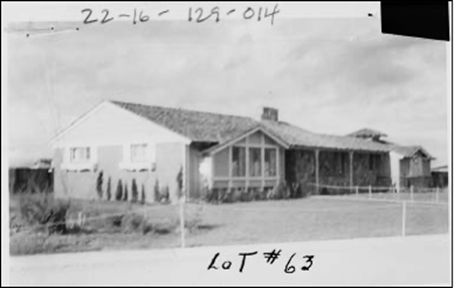

National Register of Historic Places
5476 South Fairoaks Drive
The Dover was designed and constructed by Grant A. Muhlestein and was highlighted as a “near replica of the homes of Old England, featuring, however, all the modern devices that make life comfortable” (Deseret News and Salt Lake Telegram). It is a one-story, single-family Colonial Revival style ranch house. The house is positioned at the apex of a curve which allows for an especially elongated, rambling appearance. The exterior is clad with stone veneer and board-and-batten siding. The eaves are open with exposed rafters and closed in the gabled ends with wood verge boards.
The primary façade consists of a dominant front gable projection at the south end, sheltered entry and shallow porch, and a diminutive front gable over the garage at the north end. There is a broad entry porch with a prominent picture window to the right of the door. Stone veneer distinguishes the sheltered entry and tripartite picture windows. A stone veneered chimney rises from the roof ridge of the living space, and a low, broad hip roof cupola sits at the crest of the roof above the garage wing.
Source: United States Department of the Interior National Park Service National Register of Historic Places, Parade of Homes Lakewood Site Historic District
28. THE VIRGINIAN JR. (1955)
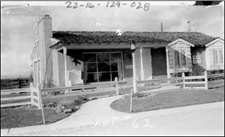

National Register of Historic Places
5490 South Fairoaks Drive
The Virginian Jr. was constructed by Glazier Construction and was described as an “Early American” design (Deseret News and Salt Lake Telegram). It is a one-story, single-family Colonial Revival style ranch type dwelling, T-shaped in plan. It is clad with a red brick veneer and wood shingles on two bay windows. An off-center entry is sheltered below the porch and is trimmed in a decorative wood surround. There are three windows in the primary façade: In the south façade of the side-gabled wing, there is another picture window which is trimmed in a decorative wood surround. A brick interior end wall chimney rises from the south gable end.
Source: United States Department of the Interior National Park Service National Register of Historic Places, Parade of Homes Lakewood Site Historic District
29. THE COTTON BOTTOM INN (1948)
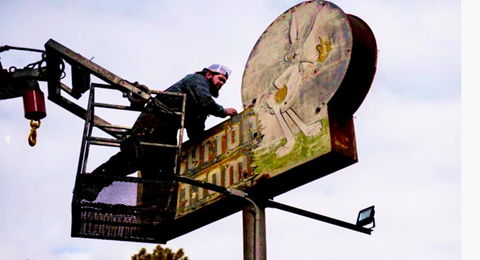

2820 E. 6200 S.
Salt Lake Tribune, June 4, 1949: “GIRL over 21 to work in the Cotton Bottom Inn. Steady work. 2780 E 62nd South.” This ad appeared several times in the summer of 1949, and is the first reference we can find to The Cotton Bottom Inn. In 1945, a business called the Cottonwood Club advertised steak, chicken, beer, and ice in roughly what is now the Cotton Bottom’s parking lot. A 1949 article in The Salt Lake Tribune reports police seizing a slot machine from the Cotton Bottom.
It's not until 1952 that these snippets coalesce in Dewain Nelson purchasing the Cotton Bottom Inn. He began ran it until around 1956, then leased the business to Helen Chlepas in 1966. Helen developed the now-famous garlic cheeseburger, and she and her son Tony ran the tavern until her death, then Tony continued. The tavern remained in the Chlepas family for about 50 years. Stacy Chlepas Holst, Helen’s granddaughter, continues the tradition -- she has been working there for more than 20 years.
In 2014, the Chlepas family sold the tavern to the City of Holladay; the City then leased it back to the Chlepas family. There was talk of demolishing it and possibly building a fire station on that corner, known locally as Knudsen’s Corner. When citizens complained, one Holladay City councilperson pointed out, “Holladay City can’t be in the business of running a bar.”
In 2020, during the pandemic, the Bar X Group, who owns Bar X, Beer Bar, and The Eating Establishment in Park City, rescued the Cotton Bottom by purchasing it from the City. They reopened in December after upgrading the facilities. With Stacy as co-manager, this made 68 years with a Chlepas in the kitchen. They also repaired the historic white cottage on the property to use as dining overflow on the porch (more on that below). Brimley Neon, who repaired the Bar X sign downtown decades ago for the group, removed the famed Cotton Bottom bunny sign with a crane, and took it to their shop. David Brimley carefully restored it, replacing neon which had been absent for decades. The holes in the sign that everyone assumed were bullet holes turned out to be arrow holes. Some of the arrow tips were still inside the sign.
Source: Salt Lake Tribune 11/4/1949, 12/4/2020, photo 1/10/2020
Interview with owner Jeff Barnard 3/20/2024
Adrienne White, Housegeneaology.us
30. THE COTTAGE AT KNUDSEN’S CORNERS (1900)

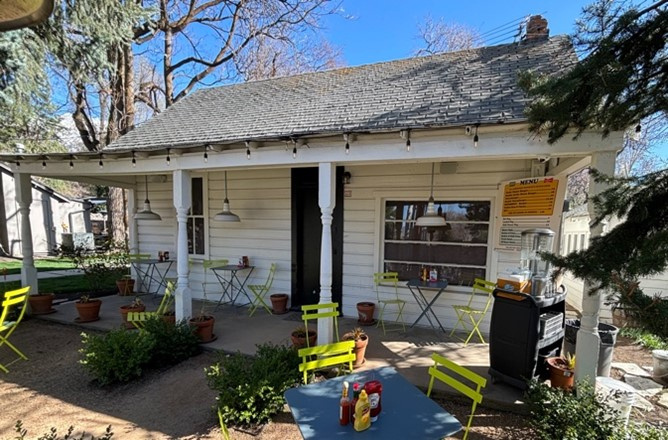
2820 E. 6200 S.
Although the two buildings are each a part of the Cotton Bottom, this cottage has its own story. According to Salt Lake Tribune journalist Jack Goodman, who lived and wrote in the neighborhood of Knudsen’s Corner for decades, Rasmus Christian Knudsen bought a 40-acre parcel in this area on May 1, 1882. “The seller was Edward Woods – a black man, a considerable rarity in Utah. Woods, whose history I don’t know, could not write, but made his ‘X mark’ on the deed of sale and apparently then left the area.”
Goodman interviewed Rasmus Knudsen’s great-grandson, Darwin Knudsen, in 1997. Knudsen said that his ancestors built this 552 square foot cottage out of adobe, which was later clad in wood siding. There are two windows and a central door on the front façade and the porch roof is supported by lathe-turned pillars. Knudsen’s grandfather Rudolph built this house as a wedding present for his son, Frederick and his wife Mary Cahoon. The Knudsen family referred to it as the “Honeymoon Cottage.”
Goodman said Helen Chlepas knew much of the history of the building, but “she is usually so busy turning out garlic burgers that she can hardly find time to respond to questions.” Knudsen reflected on what the neighborhood was like back then. “When I first remember the house as a boy, it faced a dirt road (6200 South) and was protected by a wooden fence… Our family had greyhounds then – and some neighbors had big fighting cocks. Yes, there were illegal cockfights out this way years ago… We kids were playing behind some bushes when along came three or four riders dressed in English-style hunting outfits – derby hats, scarlet coats and shiny boots. They were following a pack of hunting dogs which may or may not have been chasing a fox. Yoicks!” Goodman posited that the Bamberger and Auerbach families who lived nearby were apparently conducting formal hunts in the area.
The cottage is no longer on a dirt road and surrounded by greyhounds and hunters – it’s surrounded by strings of lights and appreciative diners, eating mostly garlic cheeseburgers.
Source: Salt Lake Tribune, City View column, Jack Goodman, 12/21/1997
Adrienne White, Housegeneaology.us
31. MEIER’S
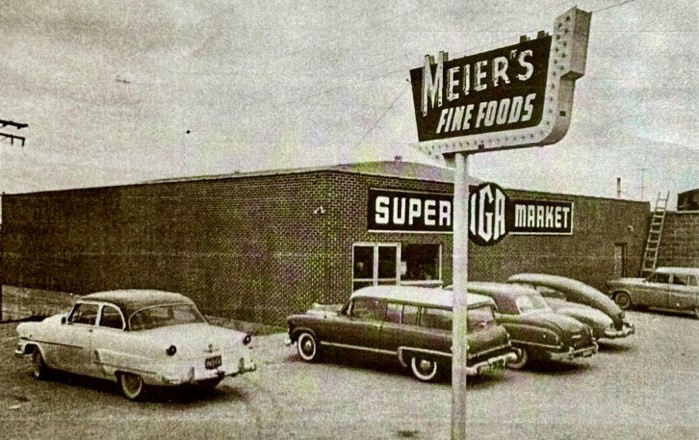

4708 S. Holladay Blvd.
These businesses were both created by Kathryn and Robert Meier in the 1940s and 1950s. The building on the right was built in the late1940s, owned by Mildred and Bill Howard, and housed I.G.A. Stores. In 1972 the Meiers purchased the building and opened an I.G.A. Grocery Store. It remained so until 1972. The Meiers purchased the building in 1977 and opened Meiers Country Fried Chicken. Meiers fried chicken was well known in the area and people were sad to see it go when it closed in 2023. The building is now transformed into the Fox Market which sells ice cream, pastries, home goods, and antiques. It is run by Cara Fox.
The building on the left was built in 1954 and owned by Mildred and Bill Howard. Meiers opened a Grocery Store in 1955, sold the business, then reappeared in 1961 as Meier’s Market and meat market until 1990, when they closed that business and opened Meier’s Catering. The Meier family has been catering in that location since then.
In 2020 the Meiers purchased the building from the Paul Howard Estate.
Source: Meier family interview with Sandy Meadows, Chairperson Holladay Historical Commission 3/2024
32. BURTON LUMBER

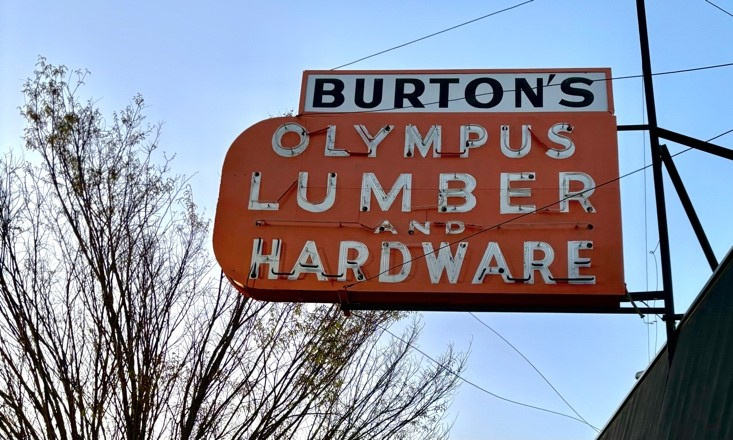
4639 Holladay Blvd
Burton Lumber has been in operation since 1911 and is now in its fifth generation. It started out on State Street, using a wagon and horse that originally belonged to the Salt Lake Fire Department. When a fire alarm sounded, it was hard to get the horses not to run off to the fire. Burton acquired the Holladay yard from Olympus Lumber and Hardware in 1966.
Source: Burton Lumber Company, Interview with Sandy Meadows, Chairperson Holladay Historical Commission 3/2024
33. THE STORE

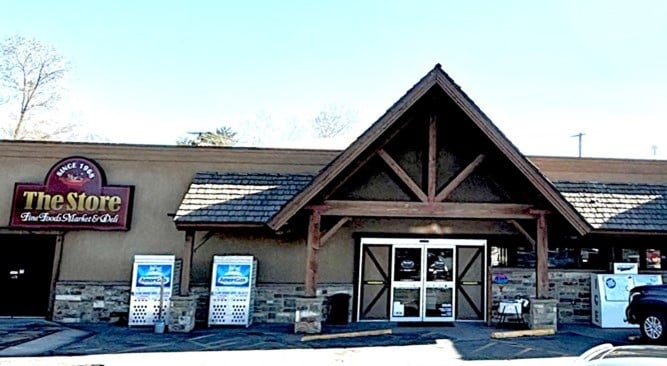
2050 E. 6200 S.
It’s anyone’s guess if the Salt Lake County Assessor photo on the left, of Valley Shopping Center is where the current store is built. A mom-and-pop grocery store in Holladay, The Store has been catering to locals since 1968. This small store with a connection to a loyal customer base, has been owned by Jeff Niederhauser since 1998.
Source: Utah Business Magazine 11/1/2005
Photo Salt Lake County Assessor
34. LESLIE’S FRENCH PASTRIES

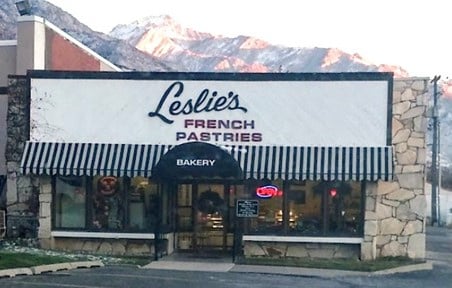
2308 Murray Holladay Rd.
The original Leslies were Alex and Betty, who were born in Scotland and immigrated to the U.S. in 1948. They worked for Glawson Bakery for 25 years. In 1975, the Leslies, their son Bill and daughter-in-law Kim, wanted to open a bakery near their home in Holladay -- so Leslie’s French Pastries at 4658 Holladay Blvd became a reality. Bill and Kim passed along to their four children the lessons they learned from Alex and Betty, who often worked 14 hours a day. Their signature dishes -- Danish rings, chocolate rum cakes, and other pastries – were all made from scratch. After 34 years, when Holladay Village was built, Leslie Bakery moved to Murray Holladay Road. In 2023, Leslies sold to Luis and Stephanie Herrera who continue the pastries tradition.
Source: Newspapers.com
Owners Bill and Kim Leslie, interview with Sandy Meadows, Chairperson Holladay Historical Commission 3/2024
35. WARE & TREGANZA BRIDGE (1915)

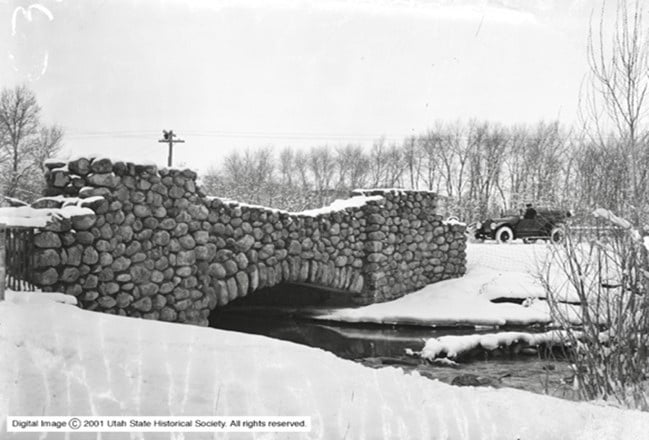
2800 E. Big Cottonwood Rd.
n 1913, Salt Lake County commissioners announced a plan to introduce beauty and art into public structures like bridges, parks, and ponds. The idea was introduced to the Utah Association of Architects, and a call for sealed bids was sent out for two bridges: one for a concrete bridge over the lower power plant in Big Cottonwood Canyon and another over the same creek at Knudsen’s Mill. Plans for these structures had historically been drawn by the county surveyor’s office. It was thought that, while these employees were good engineers and could make plans for substantial bridges, they were not always artists and the bridges were not always beautiful. Commissioners decided that architects and engineers would work together on the plans. This is to avoid bridges that one prominent man remarked looked like they were “drawn with a ruler.”
Ware and Treganza’s design won first prize. They were a prolific architectural firm in Utah and their designs can be seen listed above in the Mort Cheesman House and the Ross Hame, as well as in The Ladies Literary Clubhouse, the Sweet Candy Company Building, and the sexton’s house at Mt. Olivet Cemetery. The new bridges would cost $1,500 each -- $500 more than former bridges -- and thought to be worth the extra expenditure. Both bridges were to be built of concrete and huge boulders gathered from the sites.
The north parapet of the bridge is missing, damaged in the 1983 flood, but the south side remains. It is owned by the City of Holladay.
Sources: Salt Lake Tribune 5/28/1913; 6/8/19131913; 6/13/1913
Interview with architectural historian David Amott, 3/17/20242024
Photo: Utah State Historical Society

This information was prepared by Kim Hancey Duffy. Please send corrections, additional history and photos to Megan Attermann, Arts & Culture Manager, using the email address below.
history@holladayUT.gov
office address
4580 S. 2300 E.
Holladay, UT 84117
phone number
(801) 527 2677